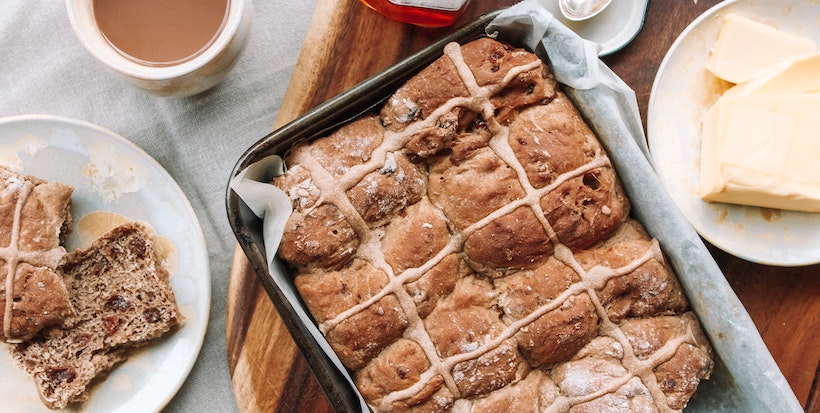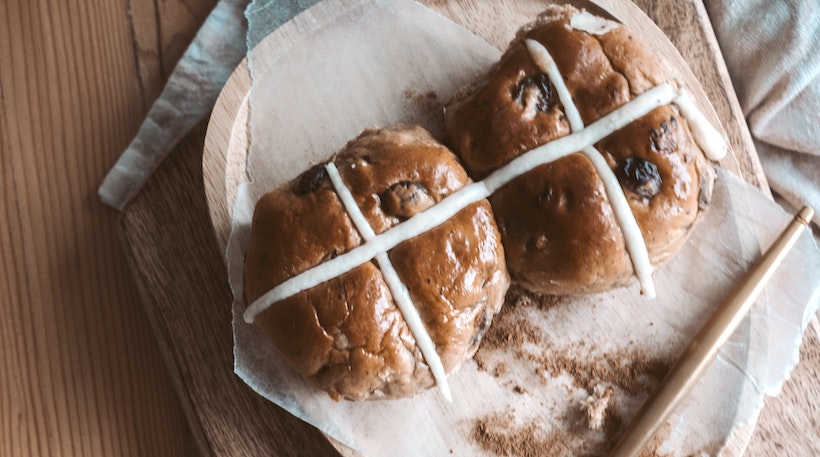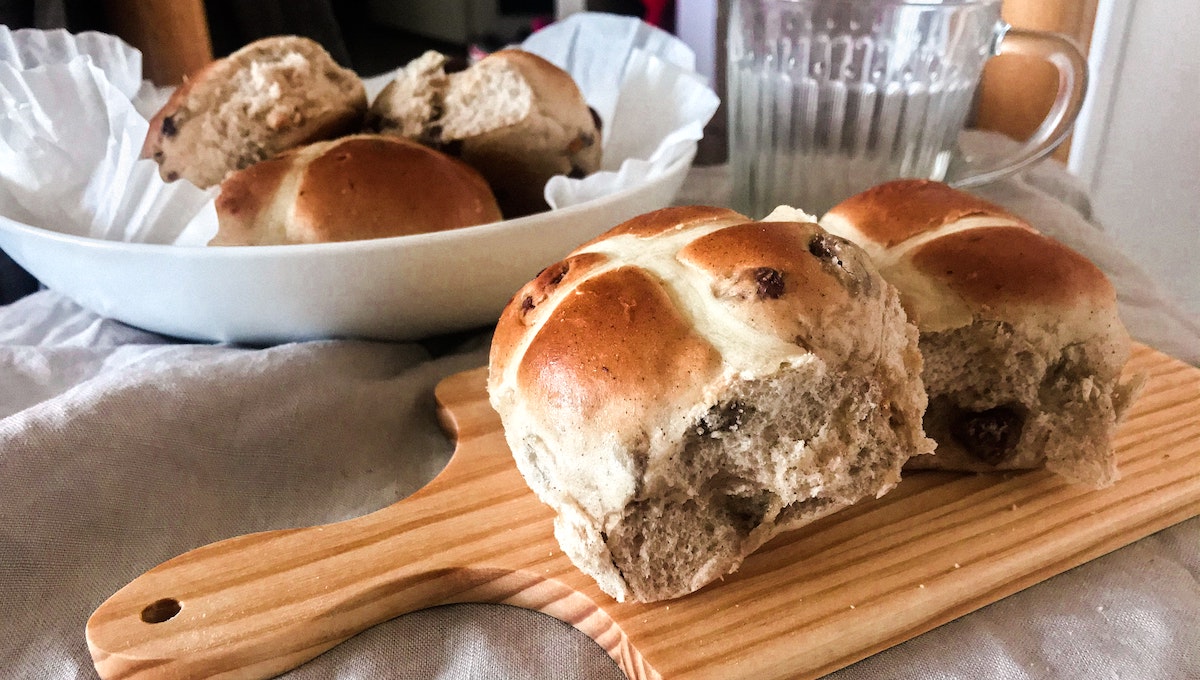What do you think about when you think about hot cross buns? The street vendor's cry enshrined in the classic nursery rhyme, "One ha' penny, two ha' penny, hot cross buns!"? (Maybe played on the recorder?) Maybe Good Friday?
The spiced sweet bun with a cross on top is an inseparable part of the British Isles' Easter tradition. And – I'm excited to say – the history of hot cross buns starts in ancient times and travels down a winding road through the centuries.

Hot cross buns are a sweet, spiced baked pastry marked with a cross on top. The baker can etch said cross into the dough, make it from a paste of flour and water, or pipe it with icing.
The essential ingredients of hot cross buns are flour, yeast, sugar, eggs, butter, and milk. The milk and butter in the dough mark Lent's end, during which dairy products are forbidden – a tradition I wrote a little more about around Pancake Tuesday.
As for the twists? Many recipes include cinnamon and raisins, but many variations incorporate ingredients like currants, dried cranberries, and candied citrus peels. With all the variations, the dough is sticky, and it's important not to add too much flour if you want your buns to turn out well.
Once the buns are ready, the baker glazes them with a syrup made of sugar and water for a shiny, sweet finish.
Older hot cross buns recipes give a result that resembles a shortcrust pastry and makes it easy to carve crosses into the dough. Modern hot cross buns are more like soft rolls, so it's more convenient for the baker to use icing for the crosses. Not universally, though – you'll find recipes that target the more traditional texture, as well.
As an interesting note, a newer variation that started in Australia in 2014 is the not cross bun. It uses similar ingredients but displays a non-religious smiley face instead of a cross on top. "Not cross," in this case, means "not angry."
Christians associate hot cross buns with the Easter holiday and the resurrection of Jesus. The cross on top of the bun represents Jesus' crucifixion, while the spices symbolize his embalming before his burial.
Christians who observe Lent's traditions do not eat dairy starting the evening of Shrove Tuesday until midday Good Friday, which precedes Easter Sunday. The traditional time to eat hot cross buns is on Good Friday.

Although cross buns are a traditional Christian baking staple, history shows that they have distinct pagan roots. Ancient Romans used to offer cross-marked buns to Diana, goddess of the hunt and moon. An excavation in the ruins of Pompeii revealed remains of cross-marked cakes.
The Saxons ate round cakes called 'hlaf', said to be much like the Roman loaves—and likely the British Christian cross buns' progenitors. For the spring festival of the goddess Eostre (for whom "Easter" is possibly named), the Saxons baked buns etched with horns in a cross shape that symbolized the four quarters of the moon's cycle.
Scholars believe that the word "bun" itself comes from the ancient Greek "boun," which means "ox" or "cow." In this retelling, worshippers may have offered a cake to the gods instead of an actual animal.
Once Christianity arrived on the scene in Britain, it eradicated pagan worship traditions but left their springtime holiday dates in place, dressing them up to fit in with the Church's teachings. The cross of horns became the Christian symbol of Jesus' cross, and their Spring Equinox festivities became Easter – which still follows the lunar calendar as a movable holiday.
One of the oldest known ancestors of the modern hot cross bun is the Alban bun, which originated in St. Alban's Abbey in England. Brother Thomas Rodcliffe, a monk at the abbey, would hand out these buns to the poor on Good Friday starting around 1361.
Although the original Alban bun recipe remains unknown, we know that the recipe called for flour, fresh yeast, eggs, currants, and grains of paradise or cardamom. The cross was cut into the dough rather than pasted or piped on.
Despite their increasing popularity in England, cross buns couldn't avoid some controversy!
In 1582, the London Clerk of Markets issued a ban on bakery-produced cross buns because of a (false) rumor that claimed the buns had medicinal or magical qualities.
In 1592, Queen Elizabeth I released a decree that only allowed selling cross buns on Good Friday, Christmas, and during burials.
However, nothing could stop the good folk of England from enjoying their beloved Easter pastry! People started to bake the buns at home.
However, penalties were relatively light – whenever someone was caught red-handed, their illegal buns were confiscated and given to the poor.
Called only "cross buns" at first, the name "hot cross buns" likely came from the vendors' cry while selling them on the streets. In 1733, the first mention in print of hot cross buns connected with Good Friday appeared in Poor Robin's Almanac, which immortalized the London street cry you already know: "Good Friday comes this month, the old woman runs / with one or two a penny hot cross buns."

A fascinating tale connects hot cross buns and the old London pub called The Widow's Son, established sometime in the 1830s or 1840s.
According to tradition, the pub used to be a cottage belonging to a widow whose son went to sea. As the mother waited for her son to return, she baked a hot cross bun for him every Good Friday. The buns continued to pile up in a net hanging from her ceiling, year after year, as he unfortunately never returned.
After the widow passed away and the house became a pub, sailors began to appear on Good Fridays and hang up hot cross buns in the net above the bar. By 1921, the bar had 84 buns – one for each year since at least 1837. Although the bar has changed hands several times, the hot cross bun tradition continues to this day. Locals call the place "The Bun House."
Today, hot cross buns are available throughout the year, though they still enjoy a surge of popularity before Easter. They are especially popular in the United Kingdom and its former colonies, including Ireland, the United States, Canada, Australia, and New Zealand.
Modern bakers give the traditional hot cross bun many interesting twists, adding ingredients like chocolate, banana, caramel, ginger, or even spiced rum.
The largest hot cross bun in the world was made on April 5, 2012, in Bolton, England. It weighed 370 pounds, 6 ounces—or 168 kg. A group of five bakers from the Royal Society for the Protection of Birds (RSPB) and Greenhalghs Bakery worked on this extra-large treat, which took up over 145 pounds of flour.
Although the age of superstitions is behind us, some people still believe that:

Aren't hot cross buns a fun tradition? From blasting out the notes on the recorder and singing the song, it was awesome to dive into the foods' history.
And I do want some of those traditions to come true. Now that we've shared the hot cross buns tale, I hope we stay friends for a year – or more!